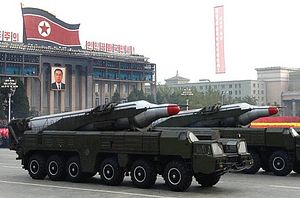On Saturday, U.S. Strategic Command (STRATCOM) said that it had detected a failed North Korean missile launch on Friday, October 14. The launch, which STRATCOM said was “presumed to be a Musudan intermediate-range ballistic missile,” was initiated “near the northwestern city of Kusong.”
If the missile was indeed a Musudan, or Hwasong-10, Friday’s attempted test would have been the seventh this year. North Korea began a spate of Musudan testing in April 2016, with its sixth test in June 2016 demonstrating success with a reported apogee of around 1,000 kilometers and a flight distance of 400 kilometers.
STRATCOM’s statement regarding the October 14 test offers little additional information regarding the test. Given that STRATCOM was able to detect a launch, it is unlikely the missile detonated immediately upon launch and acquired reasonable altitude before encountering failure, potentially giving North Korea useful data in the process. Wire reports note that the “projectile reportedly exploded soon after liftoff.”
Moreover, as Nathan J. Hunt observed after the test, the launch location of Kusong is notable. Hunt notes that North Korea “has been conducting test launches from the countries East Coast near Wonsan, but yesterday DPRK attempted launch of a Musudan missile came from the area of Kusong.”
We also don’t know the trajectory of North Korea’s planned launch. As Hunt observes, there are really only two possibilities here that would have kept the missile out of third-country airspace in the event of a successful test. North Korea could have been going for either a lofted or regular trajectory launch into the Yellow Sea (like it has done with its satellite launch vehicle launches). Alternatively, Pyongyang could have been attempting an west-to-east overflight of North Korean territory into the Sea of Japan. In August, a North Korean Nodong intermediate-range ballistic missile splashed down in Japan’s exclusive economic zone for the first time ever, drawing a sharp reaction from Japan.
Friday’s test, moreover, marked the first provocative act by North Korea since its test of an 80 ton-force rocket booster in September and, more significantly, its fifth nuclear test also that month. As usual, the attempted launch drew condemnations from the United States, South Korea, and Japan. “We strongly condemn this and North Korea’s other recent missile tests, which violate U.N. Security Council Resolutions explicitly prohibiting North Korea’s launches using ballistic missile technology,” said Cmdr. Gary Ross, a spokesperson for the U.S. Department of Defense.

































